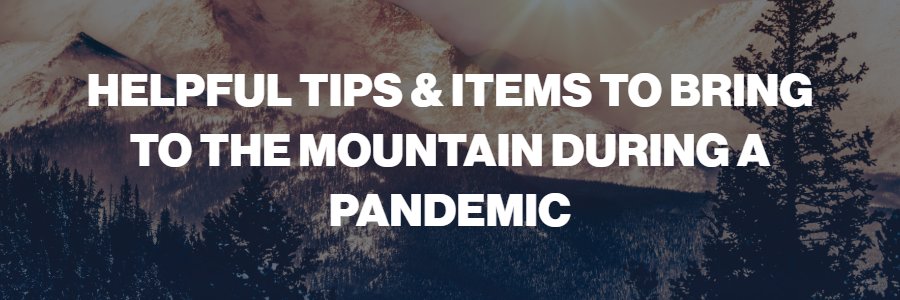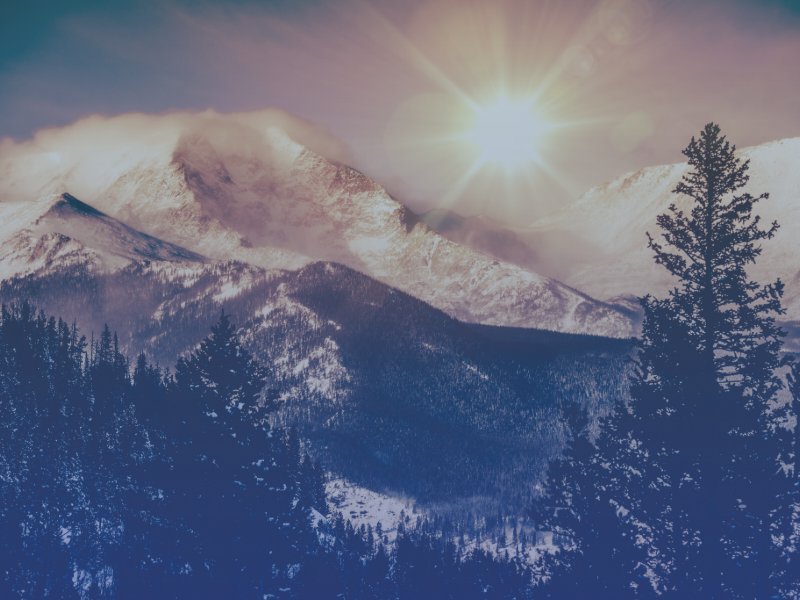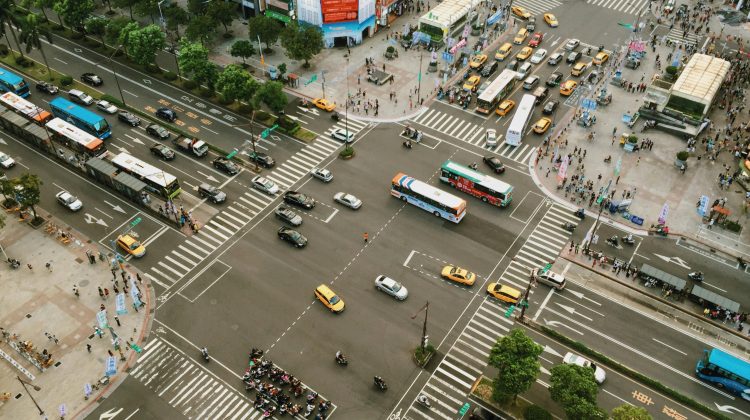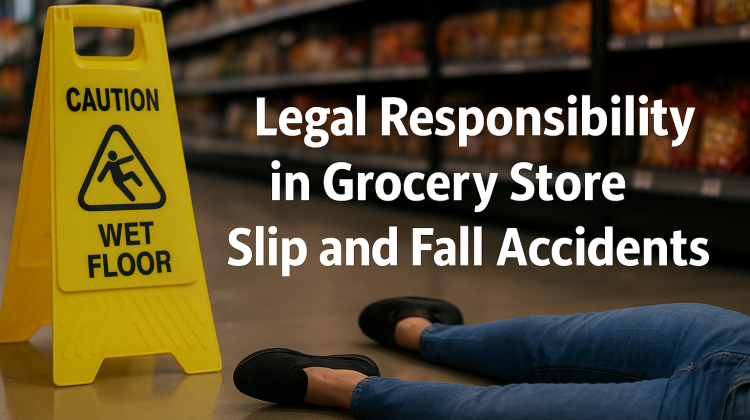Historically, January is one of the heaviest months of snow of the calendar year in North America. The temperatures are cold and large winter cells form and drop precipitation in the form of snow on mountainous regions.
Generally a peak part of the tourism season for mountain towns from Big Bear, CA to Stowe, VT (and every mountain town in between) January, and the 2021 snow season, will look a lot different this time around compared to twelve months ago.
However, when a skier or rider arrives at a mountain their experience may be contingent upon several factors including local and state government regulations, the local positivity rate of the county and surrounding areas, and the number of available ICU beds for emergency services.
Essentially what a mountain looks like, and operates like, in Salt Lake City and Lake Tahoe may have entirely different rules, regulations and policies in place. To make matters even more complicated, the COVID-19 pandemic is a fluid situation and what is acceptable at a resort one week, can change and fluctuate to the next.
To help prepare for the winter season we examine some FAQs and helpful items to bring on the next trip to the mountains.
What Should I Bring to a Mountain Resort During the Pandemic?
Face Masks
Don’t forget a face mask or covering. On cold days with high wind chills, you may be happy you brought a warm gaiter or balaclava, however any face covering that envelopes one’s mouth and nose should satisfy the resort’s face covering requirements. The face coverings should allow for breathing without restriction and have multiple layers of fabric. Face coverings should be worn in all public settings to help minimize the spread.
It’s better to be safe than sorry on this front and many resorts in the United States have requirements on face coverings. Do yourself, your loved ones and the people around you a favor and bring a face mask to any outdoor activity to help slow the spread.
Foldable Chairs
It may sound a bit odd, but bringing some foldable or compact chairs with your person may come in handy as well. During a recent visit to a mountain resort in Southern California, it was incredibly difficult to find anywhere to sit. While riding by myself, I understood the importance of social distancing. However, due to the closure of indoor dining halls and restaurants, all eateries and available seating was pushed outdoors, resulting in a very limited number of seats for the mountain’s patrons.
Dependent on the amount of people on the mountain in a given day, one can leave the foldable chairs in their vehicle, if the parking lot is not too far away. However, on busier days and peak weekends, it may be best to rent a large enough locker to store the foldable chairs. This is especially true in the State of California where indoor dining is currently restricted.
When there’s nowhere to sit at lunch, or to rest your legs outside of the cold snow, riders and skiers alike may be very grateful that they brought foldable chairs.
If you want to play it safe and ensure that you and your group are not left stranded eating, drinking or conversing in the snow, plan ahead and bring some compact chairs. An added plus is you won’t be one of the snow vultures circling the limited amount of benches and stools for a seat.
Soft & Hard Goods
With all of the safety requirements, social distancing guidelines and reservations in place it may be easier than ever to forget equipment. Ensure that you have all of your soft and hard goods packed up and ready to go the day or night before you venture on your trip. Don’t forget the helmet that can save lives and minimize brain injuries.
Water & Reusable Containers
Due to local, county or state regulations those water stations you used to use to fill up your water may be a thing of the past. Recently on a trip to a mountain resort in San Bernardino County, CA no water stations were available for the general public, as they had been removed to limit COVID-19 exposure.
If you get thirsty on the mountain ensure that you bring some sort of receptacle to help hydrate your body. Camelbacks and other types of water bladders affixed to an individual’s back are a great way to ensure the needed hydration on a mountain. Coming prepared with water can also help minimize spending on the mountain for overpriced refreshments.
Savvy individuals can bring large containers of water for their household and store it in one an on mountain locker. However, remember that if the temperature is below freezing, your water may very well freeze. An indoor locker out of the cold may be your best bet for storing water.
Backpacks
Some people enjoy riding with a backpack, while others choose not to. However, in a pandemic a backpack can help store some of your soft goods if you get too hot. With the requirements for face coverings, one may be surprised how hot their person can become while skiing or snowboarding on a mountain.
A person’s body temperature whether, too hot or too cold, can have an impact on their experience on a mountain. With the vast majority of mountains mandating face masks, you may be surprised how much warmer you are compared without a mask. Standing in the lift line may have acted like a cool down period in years past, but in 2020 breathing into a facemask can increase a body’s temperature that quickly leads to fatigue.
A backpack provides a storage unit in the event that an individual decides to ditch their jacket or another layer on their person.

Are Visitors Allowed at Mountain Resorts?
Another contingent answer on this one, but simply put it depends. Certain resorts only allow patrons with a day or season pass on the mountain, while other resorts may allow individuals without day or season passes to use communal areas. Always check a specific mountain’s regulations before embarking on an adventure and remember to check before heading up as the situation is fluid and can change quickly.
Additionally, remember to check the local and state ordinances of a region before heading out on any day or overnight excursion. Publicly traded companies that own the entities like the IKON and EPIC pass may have their own rules and regulations.
Do I Need to Make a Reservation for a Mountain Resort?
Best advice – check before you go. Even if you dropped some coin on that top of the line, blackout date free season pass, that doesn’t guarantee you have a spot on the mountain for a day during the season.
Flexibility for passholders during the 2020/2021 season has been encroached upon by COVID-19, and ski bums across North America need to adjust accordingly. Simply put, know before you go and plan ahead. This will help minimize potential headaches. What works for one resort in Colorado, may differ from another resort within Colorado. This situation is also fluid. To best ensure you and your group get to ride, make a reservation as far in advance as possible. Popular holiday weekends fill up weeks to months in advance, so the more notice the better.
Season Ticket Holders
Like most everything else since the pandemic hit, resorts have implemented new procedures and protocols. One of these procedures may be the requirements for advance reservations even for season ticket holders. If you have an IKON pass, ensure that you check the resorts that mandate a reservation.
For Epic Pass Holders, all of their resorts require a reservation. Know before you go and plan ahead to alleviate any avoidable stressors.
Day Passes
Don’t expect to be able to show up to the resort, stand in line and purchase a day ticket like in the pre-covid days. Like everything else in 2020 it is best to plan ahead. Check your resort’s requirements before venturing out. The last thing you want to do is pack up your group for a snow day and be stuck at the mountain with nothing to do but turn around and head back home.
Lift Lines Can Vary
Dependent on the local state where you are riding the social distancing guidelines, reservation requirements and thus lift lines, may vary. In non-pandemic times, lifties will do their absolute best to expedite the lift lines, by grouping small groups and singles together.
However, due to social distancing guidelines, many chairs are going up half empty, or even with one single on a chair. As a result, lift lines may be longer than expected. The reservation system implemented by certain resorts may help alleviate overcrowding, but when chairs are going up at less than one hundred percent capacity, the lines may belonger than in years past.
Summary
To summarize, many mountains in the United States look and feel significantly different in 2020 compared to years and decades past. Do not rely on things that previously worked or that were once acceptable. In this world and global climate, the only constant is change. As such patrons and visitors will need to adjust some of their previous habits for ones that help minimize the spread of COVID-19.
Just like the local, state and federal government’s response to the pandemic itself has been muddled and mixed, so too have procedures for several mountain resorts in the United States.
There is no definitive or binary answer to help skiers and riders know the requirements across the country, rather it is imperative that everyone plan ahead this year. Make plans with as much time as possible. It’s better to be over prepared than under prepared. If you don’t know check the website of the resort in question. Planning ahead and bringing some helpful supplies can help minimize the impact of the new requirements on your party. Have fun, stay safe and enjoy the mountain responsibly!





No Comment